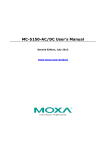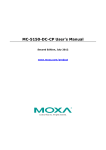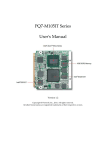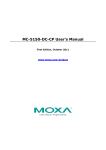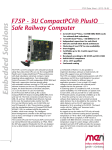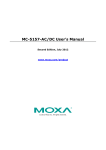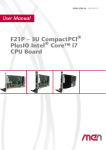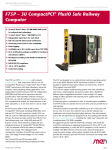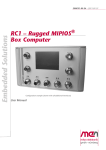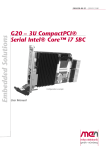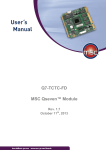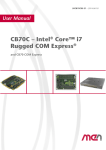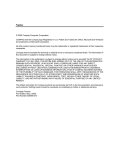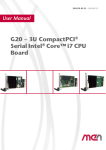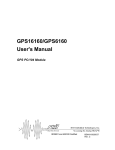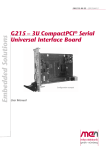Download 20SC27-00 E2 User Manual - Diamond Point International
Transcript
20SC27-00 E2 – 2013-10-22
User Manual
SC27 – Intel® Atom™ SBC
for Intelligent Displays
Configuration example
SC27 – Intel® Atom™ SBC for Intelligent Displays
SC27 – Intel® Atom™ SBC for Intelligent Displays
The SC27 is a rugged, fanless and maintenance-free single-board computer for
rugged display computers, e.g., for in-seat infotainment purposes in trains, public
buses or airplanes. Its small size makes it suitable for display devices with TFT
LCD panels as small as 7".
The SC27 is controlled by an Intel® Atom™ E6xx processor running at 1.6 GHz
and comes with 2 GB of DDR2 SDRAM and a MicroSD card slot. The standard
interfaces comprise one Fast Ethernet (via M12 connector), two USB ports as well
as a GNSS and RS232 or RS422/485 interface. Further I/O can be added via SAAdapters™. A temperature sensor is provided to monitor and control the display.
The board's microSIM card slot and the microSD™ card slot can be made
accessible on the display computer.
The SC27 is equipped with an internal 10 to 50.4 V (24 VDC nom. or 36 VDC
nom.) wide-range power supply and able to operate in a -40 to +85°C environment
with sufficient cooling. Optionally the SC27 can be supplied by a Power over
Ethernet source with a power range of 37 to 57 V (48 VDC nom.). The SC27
provides EN 50155 conformity, which makes it ideal for any kind of railway
application. All electronic components are soldered to withstand shock and
vibration and are prepared for conformal coating.
Options include other types of the Intel® Atom™ E6xx series and a UART or CAN
bus interface via an SA-Adapter™. A PCI Express® Mini Card slot (with a
microSIM card slot) in combination with an external antenna can be used to
incorporate wireless functions like Wi-Fi, WIMAX, GSM/GPRS, UMTS, HSDPA
and LTE.
MEN Mikro Elektronik GmbH
20SC27-00 E2 – 2013-10-22
2
Diagram
Diagram
2 GB
DDR2 SDRAM
Backlight control
B
LVDS
B
SMBus
B
Board‐to‐Board Connector
USB 2.0
Board Management Controller
USB 2.0
B
USB 2.0
B
SATA
B
USB 2.0
B
SA
UART/CAN
Intel® AtomTM Processor
and
Intel® Platform Controller Hub
EG20T
mSATA B
PCIe Mini Card Slot
B
microSIM Card Slot
B
microSD Card Slot
B
PCIe x1
USB 2.0
UART
B
GNSS
TM
B
USB 2.0
B
RS232 or RS422/485
USB
GPI
B
B
UART
10/100Base‐T
PoE
10/100Base‐T
MEN Mikro Elektronik GmbH
20SC27-00 E2 – 2013-10-22
Power Supply
B
On‐board connector
SA
SA‐Adapter™
Option
3
Technical Data
Technical Data
CPU
• Intel® Atom™ E680T
- 1.6 GHz processor core frequency
• Chipset
- Intel® EG20T Platform Controller Hub (PCH)
Memory
• 2 GB DDR2 SDRAM system memory
- Soldered
- 800 MHz memory bus frequency
• 16 Mbits boot Flash
• mSATA disk slot
- Connected via one SATA channel
- SATA Revision 2.x support
- Transfer rates up to 300 MB/s (3 Gbit/s)
• One microSD™ card slot
- Via USB
Graphics
• Integrated in Intel® Atom™ processor
• One single-channel LVDS interface via board-to-board connector
- For connection to a display adapter board
- 80 MHz maximum pixel clock
- Maximum resolution of up to 1280x768 @ 60 Hz
PCI Express® Mini Card slot
• PCI Express® and USB interface
• microSIM card slot
GPS Interface (Rev. 00.xx.xx)
•
•
•
•
•
48-channel GPS (Global Positioning System) receiver based on SIRF IV
GPS Band/Code: L1 frequency, C/A code, SPS
Integrated TCXO, RTC
Time mark signal is readable by application software
Accuracy (unaided):
- Position: 2.5 m (CEP50)
- Velocity: 0.01 m/s (50%)
- Time: 1 μs typ.
• Time To First Fix (TTFF):
- Cold start: 35 s typ.
- Warm start: 35 s typ.
- Hot start: 1 s typ.
MEN Mikro Elektronik GmbH
20SC27-00 E2 – 2013-10-22
4
Technical Data
• Sensitivity:
- Acquisition (cold): -147 dBm
- Re-Acquisition: -162 dBm
- Tracking: -163 dBm
• Protocol: NMEA 0183 (configurable to SiRF® binary OSP)
• One U.FL antenna connector
- For the use of an external active or passive antenna
- Connected via UART
- Data transfer rate configurable (default: 4800 baud 8N1)
GNSS Interface (Rev. 01.xx.xx)
•
•
•
•
•
•
•
•
•
32-channel GNSS (Global Navigation Satellite System) receiver
GPS Band/Code: L1 frequency
Integrated TCXO, RTC
Time mark signal is readable by application software
Accuracy (unaided):
- Position: < 1.5 m
- Time mark pulse: 15 ns standard deviation
Time To First Fix (TTFF):
- Cold start: < 35 s
- Warm start: < 35 s
- Hot start: < 1 s
Sensitivity:
- Acquisition (cold): -146 dBm
- Tracking: -158 dBm
Protocol: NMEA 0183
One U.FL antenna connector
- For the use of an external active or passive antenna
- Connected via UART
- Data transfer rate configurable (default: 9600 baud 8N1)
I/O
• USB
- One USB 2.0/1.1 port via Type A connector
- One USB 2.0/1.1 port via M12 connector
- OHCI (USB1.1) and EHCI (USB2.0) implementation
- Data rates up to 12 Mbit/s (for USB1.1)
- Data rates up to 480 Mbit/s (for USB2.0)
• Ethernet
- One 10/100Base-T Ethernet channel
- Accessible via M12 connector
- Power over Ethernet Class 0 optional
• One RS232
- Accessible via M12 connector
- RS422/RS485 optionally available
• One GPI line (General Purpose Input)
- Accessible via M12 power input connector
MEN Mikro Elektronik GmbH
20SC27-00 E2 – 2013-10-22
5
Technical Data
Intelligent Power Supply with Board Management Controller
• Voltage supervision
• Temperature supervision via sensor
• Backlight control
- 12 V backlight supply
- Backlight enable, backlight dimming
• Real-time clock with buffer functionality via supercapacitor
• Watchdog
• Accessible via SMBus
Electrical Specifications
• Supply voltage/power consumption:
- +24 VDC/+36 VDC nom. (10..50.4 V), 10.8 W typ
- +110 VDC nom. (66..154 V), 10.8 W typ (optional)
- +48 VDC nom. (37..57 V), 10.8 W typ (optional power supply via Power
over Ethernet)
- EN 50155 power interruption class S2
Mechanical Specifications
• Dimensions: 160 mm x 110 mm x 44 mm
• Weight: approx. 165 g
Environmental Specifications
• Temperature range (operation):
- -40..+85°C (screened or with qualified components)
• Temperature range (storage): -40..+85°C
• Relative humidity (operation): max. 95% non-condensing
• Relative humidity (storage): max. 95% non-condensing
• Altitude: -300 m to +3000 m
• Shock: 50 m/s², 30 ms (EN 61373)
• Vibration (function): 1 m/s², 5 Hz – 150 Hz (EN 61373)
• Vibration (lifetime): 7.9 m/s², 5 Hz – 150 Hz (EN 61373)
• Conformal coating on request
MTBF
• 500 000 h @ 40°C according to IEC/TR 62380 (RDF 2000)
Safety
• Flammability
- PCB manufactured with a flammability rating of 94V-0 by UL recognized
manufacturers
MEN Mikro Elektronik GmbH
20SC27-00 E2 – 2013-10-22
6
Technical Data
EMC Conformity
•
•
•
•
•
•
•
•
EN 50121-3-2 (table 4, 5 and 6) / EN 55011 (radio disturbance)
EN 50121-3-2 (table 9) / EN 61000-4-2 (ESD)
EN 50121-3-2 (table 9) / EN 61000-4-3 (electromagnetic field immunity)
EN 50121-3-2 (table 8) / EN 61000-4-4 (burst)
EN 50155 / EN 61000-4-5 (surge)
EN 50121-3-2 (table 7) / EN 61000-4-6 (conducted disturbances)
Conducted Emission (Power Line): 2004/104/EC; 2005/83/EC; ISO7637-2
Prepared for certification according to e1 requirements of the German Federal
Motor Transport Authority
BIOS
• InsydeH2O™ UEFI Framework
Software Support
• Windows®
• Linux
• For more information on supported operating system versions and drivers see
online data sheet.
MEN Mikro Elektronik GmbH
20SC27-00 E2 – 2013-10-22
7
Configuration Options
Configuration Options
CPU
•
•
•
•
•
•
•
•
Intel® Atom™ E620, 0.6 GHz, 320 MHz graphics frequency, 3.3 W
Intel® Atom™ E620T, 0.6 GHz, 320 MHz graphics frequency, 3.3 W
Intel® Atom™ E640, 1.0 GHz, 320 MHz graphics frequency, 3.6 W
Intel® Atom™ E640T, 1.0 GHz, 320 MHz graphics frequency, 3.6 W
Intel® Atom™ E660, 1.3 GHz, 400 MHz graphics frequency, 3.6 W
Intel® Atom™ E660T, 1.3 GHz, 400 MHz graphics frequency, 3.6 W
Intel® Atom™ E680, 1.6 GHz, 400 MHz graphics frequency, 4.5 W
Intel® Atom™ E680T, 1.6 GHz, 400 MHz graphics frequency, 4.5 W
Memory
• System RAM
- 512 MB, 1 GB or 2 GB
I/O
• SA-Adapter™ slot
- Supports one UART SA-Adapter™ (SA1, SA2, SA3 or SA22) or one CAN
SA-Adapter™ (SA8)
Power Supply
• Power over Ethernet powered device instead of PSU
- Class 0
Please note that some of these options may only be available for large volumes.
Please ask our sales staff for more information.
For available standard configurations see online data sheet.
MEN Mikro Elektronik GmbH
20SC27-00 E2 – 2013-10-22
8
Product Safety
Product Safety
!
Electrostatic Discharge (ESD)
Computer boards and components contain electrostatic sensitive devices.
Electrostatic discharge (ESD) can damage components. To protect the board and
other components against damage from static electricity, you should follow some
precautions whenever you work on your computer.
• Power down and unplug your computer system when working on the inside.
• Hold components by the edges and try not to touch the IC chips, leads, or circuitry.
• Use a grounded wrist strap before handling computer components.
• Place components on a grounded antistatic pad or on the bag that came with the
component whenever the components are separated from the system.
• Store the board only in its original ESD-protected packaging. Retain the original
packaging in case you need to return the board to MEN for repair.
MEN Mikro Elektronik GmbH
20SC27-00 E2 – 2013-10-22
9
About this Document
About this Document
This user manual is intended only for system developers and integrators, it is not
intended for end users.
It describes the hardware functions of the board, connection of peripheral devices
and integration into a system. It also provides additional information for special
applications and configurations of the board.
The manual does not include detailed information on individual components (data
sheets etc.). A list of literature is given in the appendix.
History
Issue
Comments
Date
E1
First issue
2013-07-15
E2
Updated to Revision 01.xx.xx
2013-10-22
Conventions
This sign marks important notes or warnings concerning the use of voltages which
can lead to serious damage to your health and also cause damage or destruction of
the component.
!
italics
bold
monospace
This sign marks important notes or warnings concerning proper functionality of the
product described in this document. You should read them in any case.
Folder, file and function names are printed in italics.
Bold type is used for emphasis.
A monospaced font type is used for hexadecimal numbers, listings, C function
descriptions or wherever appropriate. Hexadecimal numbers are preceded by "0x".
comment
Comments embedded into coding examples are shown in green color.
hyperlink
Hyperlinks are printed in blue color.
The globe will show you where hyperlinks lead directly to the Internet, so you can
look for the latest information online.
IRQ#
/IRQ
Signal names followed by "#" or preceded by a slash ("/") indicate that this signal is
either active low or that it becomes active at a falling edge.
in/out
Signal directions in signal mnemonics tables generally refer to the corresponding
board or component, "in" meaning "to the board or component", "out" meaning
"coming from it".
Vertical lines on the outer margin signal technical changes to the previous issue of
the document.
MEN Mikro Elektronik GmbH
20SC27-00 E2 – 2013-10-22
10
About this Document
Legal Information
Changes
MEN Mikro Elektronik GmbH ("MEN") reserves the right to make changes without further notice to any products
herein.
Warranty, Guarantee, Liability
MEN makes no warranty, representation or guarantee of any kind regarding the suitability of its products for any
particular purpose, nor does MEN assume any liability arising out of the application or use of any product or
circuit, and specifically disclaims any and all liability, including, without limitation, consequential or incidental
damages. TO THE EXTENT APPLICABLE, SPECIFICALLY EXCLUDED ARE ANY IMPLIED
WARRANTIES ARISING BY OPERATION OF LAW, CUSTOM OR USAGE, INCLUDING WITHOUT
LIMITATION, THE IMPLIED WARRANTIES OF MERCHANTABILITY AND FITNESS FOR A
PARTICULAR PURPOSE OR USE. In no event shall MEN be liable for more than the contract price for the
products in question. If buyer does not notify MEN in writing within the foregoing warranty period, MEN shall
have no liability or obligation to buyer hereunder.
The publication is provided on the terms and understanding that:
1. MEN is not responsible for the results of any actions taken on the basis of information in the publication, nor
for any error in or omission from the publication; and
2. MEN is not engaged in rendering technical or other advice or services.
MEN expressly disclaims all and any liability and responsibility to any person, whether a reader of the publication
or not, in respect of anything, and of the consequences of anything, done or omitted to be done by any such person
in reliance, whether wholly or partially, on the whole or any part of the contents of the publication.
Conditions for Use, Field of Application
The correct function of MEN products in mission-critical and life-critical applications is limited to the
environmental specification given for each product in the technical user manual. The correct function of MEN
products under extended environmental conditions is limited to the individual requirement specification and
subsequent validation documents for each product for the applicable use case and has to be agreed upon in writing
by MEN and the customer. Should the customer purchase or use MEN products for any unintended or
unauthorized application, the customer shall indemnify and hold MEN and its officers, employees, subsidiaries,
affiliates, and distributors harmless against all claims, costs, damages, and expenses, and reasonable attorney fees
arising out of, directly or indirectly, any claim or personal injury or death associated with such unintended or
unauthorized use, even if such claim alleges that MEN was negligent regarding the design or manufacture of the
part. In no case is MEN liable for the correct function of the technical installation where MEN products are a part
of.
Trademarks
All products or services mentioned in this publication are identified by the trademarks, service marks, or product
names as designated by the companies which market those products. The trademarks and registered trademarks
are held by the companies producing them. Inquiries concerning such trademarks should be made directly to those
companies.
Conformity
MEN products are no ready-made products for end users. They are tested according to the standards given in the
Technical Data and thus enable you to achieve certification of the product according to the standards applicable in
your field of application.
MEN Mikro Elektronik GmbH
20SC27-00 E2 – 2013-10-22
11
About this Document
RoHS
Since July 1, 2006 all MEN standard products comply with RoHS legislation.
Since January 2005 the SMD and manual soldering processes at MEN have already been completely lead-free.
Between June 2004 and June 30, 2006 MEN’s selected component suppliers have changed delivery to RoHScompliant parts. During this period any change and status was traceable through the MEN ERP system and the
boards gradually became RoHS-compliant.
WEEE Application
The WEEE directive does not apply to fixed industrial plants and tools. The compliance is the responsibility of the
company which puts the product on the market, as defined in the directive; components and sub-assemblies are
not subject to product compliance.
In other words: Since MEN does not deliver ready-made products to end users, the WEEE directive is not
applicable for MEN. Users are nevertheless recommended to properly recycle all electronic boards which have
passed their life cycle.
Nevertheless, MEN is registered as a manufacturer in Germany. The registration number can be provided on
request.
Copyright © 2013 MEN Mikro Elektronik GmbH. All rights reserved.
Germany
MEN Mikro Elektronik GmbH
Neuwieder Straße 3-7
90411 Nuremberg
Phone +49-911-99 33 5-0
Fax +49-911-99 33 5-901
E-mail [email protected]
www.men.de
MEN Mikro Elektronik GmbH
20SC27-00 E2 – 2013-10-22
France
MEN Mikro Elektronik SA
18, rue René Cassin
ZA de la Châtelaine
74240 Gaillard
Phone +33 (0) 450-955-312
Fax +33 (0) 450-955-211
E-mail [email protected]
www.men-france.fr
USA
MEN Micro Inc.
860 Penllyn Blue Bell Pike
Blue Bell, PA 19422
Phone (215) 542-9575
Fax (215) 542-9577
E-mail [email protected]
www.menmicro.com
12
Contents
Contents
1 Getting Started . . . . . . . . . . . . . . . . . . . . . . . . . . . . . . . . . . . . . . . . . . . . . . . .
1.1 Map of the Board. . . . . . . . . . . . . . . . . . . . . . . . . . . . . . . . . . . . . . . . .
1.2 First Operation. . . . . . . . . . . . . . . . . . . . . . . . . . . . . . . . . . . . . . . . . . .
1.3 Installing Operating System Software. . . . . . . . . . . . . . . . . . . . . . . . .
1.4 Installing Driver Software . . . . . . . . . . . . . . . . . . . . . . . . . . . . . . . . . .
16
16
18
19
19
2 Functional Description . . . . . . . . . . . . . . . . . . . . . . . . . . . . . . . . . . . . . . . . . .
2.1 Power Supply. . . . . . . . . . . . . . . . . . . . . . . . . . . . . . . . . . . . . . . . . . . .
2.1.1
Power Input Connector . . . . . . . . . . . . . . . . . . . . . . . . . . . . .
2.2 Board Supervision . . . . . . . . . . . . . . . . . . . . . . . . . . . . . . . . . . . . . . . .
2.3 Reset . . . . . . . . . . . . . . . . . . . . . . . . . . . . . . . . . . . . . . . . . . . . . . . . . .
2.4 Real-Time Clock . . . . . . . . . . . . . . . . . . . . . . . . . . . . . . . . . . . . . . . . .
2.5 Processor Core. . . . . . . . . . . . . . . . . . . . . . . . . . . . . . . . . . . . . . . . . . .
2.5.1
Thermal Considerations . . . . . . . . . . . . . . . . . . . . . . . . . . . .
2.6 Memory . . . . . . . . . . . . . . . . . . . . . . . . . . . . . . . . . . . . . . . . . . . . . . . .
2.6.1
DRAM System Memory . . . . . . . . . . . . . . . . . . . . . . . . . . . .
2.6.2
Boot Flash . . . . . . . . . . . . . . . . . . . . . . . . . . . . . . . . . . . . . . .
2.7 Mass Storage . . . . . . . . . . . . . . . . . . . . . . . . . . . . . . . . . . . . . . . . . . . .
2.7.1
microSD Card Slot . . . . . . . . . . . . . . . . . . . . . . . . . . . . . . . .
2.7.2
mSATA Slot. . . . . . . . . . . . . . . . . . . . . . . . . . . . . . . . . . . . . .
2.8 Graphics. . . . . . . . . . . . . . . . . . . . . . . . . . . . . . . . . . . . . . . . . . . . . . . .
2.8.1
LVDS. . . . . . . . . . . . . . . . . . . . . . . . . . . . . . . . . . . . . . . . . . .
2.9 PCI Express® Mini Card Interface . . . . . . . . . . . . . . . . . . . . . . . . . . .
2.9.1
Installing a PCI Express® Mini Card . . . . . . . . . . . . . . . . . .
2.9.2
PCI Express® Mini Card Connector. . . . . . . . . . . . . . . . . . .
2.10 GPS Interface (Rev. 00.xx.xx). . . . . . . . . . . . . . . . . . . . . . . . . . . . . . .
2.11 GNSS Interface (Rev. 01.xx.xx) . . . . . . . . . . . . . . . . . . . . . . . . . . . . .
2.12 microSIM Card Slot . . . . . . . . . . . . . . . . . . . . . . . . . . . . . . . . . . . . . .
2.12.1 Inserting a microSIM Card . . . . . . . . . . . . . . . . . . . . . . . . . .
2.13 USB 2.0 Interfaces. . . . . . . . . . . . . . . . . . . . . . . . . . . . . . . . . . . . . . . .
2.13.1 Type A connector . . . . . . . . . . . . . . . . . . . . . . . . . . . . . . . . .
2.13.2 M12 Connector . . . . . . . . . . . . . . . . . . . . . . . . . . . . . . . . . . .
2.14 Ethernet Interface . . . . . . . . . . . . . . . . . . . . . . . . . . . . . . . . . . . . . . . .
2.15 UART Interface . . . . . . . . . . . . . . . . . . . . . . . . . . . . . . . . . . . . . . . . . .
2.16 SA-Adapter Slot . . . . . . . . . . . . . . . . . . . . . . . . . . . . . . . . . . . . . . . . .
2.17 GPI Interface . . . . . . . . . . . . . . . . . . . . . . . . . . . . . . . . . . . . . . . . . . . .
2.18 Chipset GPIO Interface . . . . . . . . . . . . . . . . . . . . . . . . . . . . . . . . . . . .
2.19 Status LED. . . . . . . . . . . . . . . . . . . . . . . . . . . . . . . . . . . . . . . . . . . . . .
20
20
20
21
21
22
22
22
22
22
22
23
23
24
26
26
28
29
30
32
32
32
33
34
34
34
35
36
36
38
38
39
MEN Mikro Elektronik GmbH
20SC27-00 E2 – 2013-10-22
13
Contents
3 BIOS . . . . . . . . . . . . . . . . . . . . . . . . . . . . . . . . . . . . . . . . . . . . . . . . . . . . . . . . .
3.1 Main. . . . . . . . . . . . . . . . . . . . . . . . . . . . . . . . . . . . . . . . . . . . . . . . . . .
3.2 Advanced . . . . . . . . . . . . . . . . . . . . . . . . . . . . . . . . . . . . . . . . . . . . . . .
3.3 Security . . . . . . . . . . . . . . . . . . . . . . . . . . . . . . . . . . . . . . . . . . . . . . . .
3.4 Power . . . . . . . . . . . . . . . . . . . . . . . . . . . . . . . . . . . . . . . . . . . . . . . . . .
3.5 Boot . . . . . . . . . . . . . . . . . . . . . . . . . . . . . . . . . . . . . . . . . . . . . . . . . . .
3.6 Exit . . . . . . . . . . . . . . . . . . . . . . . . . . . . . . . . . . . . . . . . . . . . . . . . . . .
3.6.1
Exit Saving Changes . . . . . . . . . . . . . . . . . . . . . . . . . . . . . . .
3.6.2
Save Change Without Exit . . . . . . . . . . . . . . . . . . . . . . . . . .
3.6.3
Exit Discarding Changes. . . . . . . . . . . . . . . . . . . . . . . . . . . .
3.6.4
Load Optimal Defaults . . . . . . . . . . . . . . . . . . . . . . . . . . . . .
3.6.5
Load Custom Defaults. . . . . . . . . . . . . . . . . . . . . . . . . . . . . .
3.6.6
Save Custom Defaults . . . . . . . . . . . . . . . . . . . . . . . . . . . . . .
3.6.7
Discard Changes . . . . . . . . . . . . . . . . . . . . . . . . . . . . . . . . . .
41
42
44
51
53
55
58
58
58
58
58
59
59
59
4 Appendix . . . . . . . . . . . . . . . . . . . . . . . . . . . . . . . . . . . . . . . . . . . . . . . . . . . . .
4.1 SMBus Devices . . . . . . . . . . . . . . . . . . . . . . . . . . . . . . . . . . . . . . . . . .
4.2 Literature and Web Resources . . . . . . . . . . . . . . . . . . . . . . . . . . . . . . .
4.2.1
CPU . . . . . . . . . . . . . . . . . . . . . . . . . . . . . . . . . . . . . . . . . . . .
4.2.2
LVDS. . . . . . . . . . . . . . . . . . . . . . . . . . . . . . . . . . . . . . . . . . .
4.2.3
SATA . . . . . . . . . . . . . . . . . . . . . . . . . . . . . . . . . . . . . . . . . . .
4.2.4
USB . . . . . . . . . . . . . . . . . . . . . . . . . . . . . . . . . . . . . . . . . . . .
4.2.5
Ethernet . . . . . . . . . . . . . . . . . . . . . . . . . . . . . . . . . . . . . . . . .
4.2.6
PCI Express Mini Card . . . . . . . . . . . . . . . . . . . . . . . . . . . . .
4.3 Finding out the Product’s Article Number, Revision and
Serial Number . . . . . . . . . . . . . . . . . . . . . . . . . . . . . . . . . . . . . . . . . . .
60
60
60
60
60
60
60
61
61
MEN Mikro Elektronik GmbH
20SC27-00 E2 – 2013-10-22
61
14
Figures
Figure 1.
Figure 2.
Figure 3.
Figure 4.
Figure 5.
Figure 6.
Figure 7.
Figure 8.
Figure 9.
Map of the board – top view. . . . . . . . . . . . . . . . . . . . . . . . . . . . . . . . .
Map of the board – bottom view . . . . . . . . . . . . . . . . . . . . . . . . . . . . .
SC27 – top view . . . . . . . . . . . . . . . . . . . . . . . . . . . . . . . . . . . . . . . . . .
Position of the microSD card slot on the bottom side of the SC27 . . .
Position of mSATA slot on the top side of SC27. . . . . . . . . . . . . . . . .
Position of PCI Express Mini Card slot on the top side of SC27. . . . .
Position of the microSIM card slot on the top side of the SC27 . . . . .
Position of BMC status LED on the bottom of the SC27. . . . . . . . . . .
Labels giving the product’s article number, revision and
serial number . . . . . . . . . . . . . . . . . . . . . . . . . . . . . . . . . . . . . . . . . . . .
16
17
18
23
24
28
32
39
Pin assignment of power input connector. . . . . . . . . . . . . . . . . . . . . . .
Signal mnemonics of power input connector . . . . . . . . . . . . . . . . . . . .
Processor core options on SC27 . . . . . . . . . . . . . . . . . . . . . . . . . . . . . .
Pin assignment of LVDS connector . . . . . . . . . . . . . . . . . . . . . . . . . . .
Signal mnemonics of LVDS connector . . . . . . . . . . . . . . . . . . . . . . . .
Pin assignment of PCI Express Mini Card connector . . . . . . . . . . . . .
Signal mnemonics of 52-pin PCI Express Mini Card connector . . . . .
Pin assignment of USB Type A connector. . . . . . . . . . . . . . . . . . . . . .
Signal mnemonics of USB Type A connector . . . . . . . . . . . . . . . . . . .
Pin assignment of USB M12 connector . . . . . . . . . . . . . . . . . . . . . . . .
Signal mnemonics of USB M12 connector . . . . . . . . . . . . . . . . . . . . .
Pin assignment of Ethernet M12 connector . . . . . . . . . . . . . . . . . . . . .
Signal mnemonics of Ethernet M12 connector . . . . . . . . . . . . . . . . . .
Pin assignment of RS232 M12 connector . . . . . . . . . . . . . . . . . . . . . .
Signal mnemonics of RS232 M12 connector . . . . . . . . . . . . . . . . . . . .
Pin assignment of SA-Adapter slot . . . . . . . . . . . . . . . . . . . . . . . . . . .
Signal mnemonics of SA-Adapter slot . . . . . . . . . . . . . . . . . . . . . . . . .
GPI characteristics . . . . . . . . . . . . . . . . . . . . . . . . . . . . . . . . . . . . . . . .
Error codes via LED flashes (Rev. 01.xx.xx). . . . . . . . . . . . . . . . . . . .
SMBus devices . . . . . . . . . . . . . . . . . . . . . . . . . . . . . . . . . . . . . . . . . . .
21
22
23
27
28
31
32
35
35
35
35
36
36
37
37
38
38
39
41
61
61
Tables
Table 1.
Table 2.
Table 3.
Table 4.
Table 5.
Table 6.
Table 7.
Table 8.
Table 9.
Table 10.
Table 11.
Table 12.
Table 13.
Table 14.
Table 15.
Table 16.
Table 17.
Table 18.
Table 19.
Table 20.
MEN Mikro Elektronik GmbH
20SC27-00 E2 – 2013-10-22
15
Getting Started
1
Getting Started
This chapter gives an overview of the board and some hints for first installation in a
system.
1.1
Map of the Board
Figure 1. Map of the board – top view
Connector of microSIM/microSD carrier to SC27
Connecting cable
microSIM Card slot 1
1
Connector to microSIM/ microSD carrier
1
GNSS interface
mSATA slot
1
Mini Card slot
1
1
SA‐
Adapter slot (optional)
1
LVDS interface
MEN Mikro Elektronik GmbH
20SC27-00 E2 – 2013-10-22
16
Getting Started
Figure 2. Map of the board – bottom view
microSD card slot
1
M12 power input connector
1
USB Type A connector
M12 Ethernet connector
1
M12 Serial connector
1
M12 USB connector
1
1
BMC status LED
MEN Mikro Elektronik GmbH
20SC27-00 E2 – 2013-10-22
17
Getting Started
The microSIM and microSD card holder is connected to the main board via a 14-pin
MicroMatch cable (see Figure 3, SC27 – top view). The cable is delivered with the
SC27.
Figure 3. SC27 – top view
1.2
First Operation
You can use the following check list when installing the board for the first time and
with minimum configuration.
Connect a USB keyboard and mouse to the USB connectors of the SC27.
Connect a flat-panel display capable of displaying the resolution of 800x480 to
the LVDS connector of the SC27.
Power-up the system.
You can start up the BIOS setup menu by hitting the F2 key (see Chapter 3
BIOS on page 41).
Now you can make configurations in BIOS (see Chapter 3 BIOS on page 41).
Observe the installation instructions for the respective software.
MEN Mikro Elektronik GmbH
20SC27-00 E2 – 2013-10-22
18
Getting Started
1.3
Installing Operating System Software
The board supports Windows and Linux.
!
By default, no operating system is installed on the board. Please refer to the
respective manufacturer's documentation on how to install operating system
software!
You can find any software available on the SC27 pages on MEN’s website.
1.4
Installing Driver Software
For a detailed description on how to install driver software please refer to the
respective documentation.
You can find any driver software available for download on the SC27 pages on
MEN’s website.
MEN Mikro Elektronik GmbH
20SC27-00 E2 – 2013-10-22
19
Functional Description
2
Functional Description
The following describes the individual functions of the board and their
configuration on the board. There is no detailed description of the individual
controller chips and the CPU. They can be obtained from the data sheets or data
books of the semiconductor manufacturer concerned (Chapter 4.2 Literature and
Web Resources on page 60).
Please note that the board BSPs for the different operating systems may not support all the functions of the SC27. For more information on hardware support
please see the respective BSP data sheet on MEN’s website.
2.1
Power Supply
The board is supplied with +24 VDC and +36 VDC (10 to 50.4 V) nominal input
voltage. Optionally the board can be supplied with +110 VDC (66 to 154 V) or via
Power over Ethernet (class 0) with +48 VDC (37 to 57 V). Power over Ethernet is
accessible at the M12 Ethernet connector (see Chapter 2.13.2 M12 Connector on
page 34).
The internal power supply is EN 50155 compliant, which implies that it has a builtin power-on threshold of about 0.7xUn = 16.8 V for the 24 VDC model. Once the
unit is turned on, the input voltage may drop as low as 10 V before the board
switches off.
The internal power supply is compliant with EN 50155 class S2 und with the
automotive standard e1.
2.1.1
Power Input Connector
The SC27 provides one power input connector.
Connector type:
• 4-pin M12 receptacle
Mating connector:
• 4-pin M12 plug
Table 1. Pin assignment of power input connector
4
1
MEN Mikro Elektronik GmbH
20SC27-00 E2 – 2013-10-22
3
2
1
PWRCON_IN
2
PWRCON_GND
3
GPI
4
PWRCON_IN
20
Functional Description
Table 2. Signal mnemonics of power input connector
Signal
Direction
Function
PWRCON_IN
in
Positive input
PWRCON_GND
in
Negative input
GPI
in
General purpose input
The power input connector provides one general purpose input line. For more
information, see Chapter 2.17 GPI Interface on page 38.
2.2
Board Supervision
The SC27 provides an intelligent board management controller (BMC) with the
following main features:
•
•
•
•
•
•
•
Board power sequencing control
Voltage supervision
System watchdog
Software reset functionality
Error state logging
Power mode settings
SMBus communication with main CPU
The watchdog device monitors the board on operating system level. If enabled, the
watchdog must be triggered by application software. If the trigger is overdue, the
watchdog initiates a board reset and this way can put the system back into operation
when the software hangs.
The watchdog uses a configurable time interval or is disabled. Settings are made
through BIOS or via an MEN software driver.
In addition, the SC27 uses a temperature device to measure the local board
temperature.
MEN provides dedicated software drivers for the board controller and the
temperature device. For a detailed description of the functionality of the driver
software please refer to the drivers’ documentation.
You can find any driver software and documentation available for download on
MEN’s website.
2.3
Reset
The SC27 provides the reset signal RESET_OUT#. The RESET_OUT# signal is
available at the PCIe Mini Card connector and at the microSD card holder.
The RESET_OUT# is the platform reset of the board. It goes high at board start-up
and goes low during reset of the board.
MEN Mikro Elektronik GmbH
20SC27-00 E2 – 2013-10-22
21
Functional Description
2.4
Real-Time Clock
The supply voltage for the real-time clock is buffered with a capacitor that provides
at least 24 hours buffer time at 40°C. Optionally an additional capacitor can be
assembled to achieve at least 72 hours buffer time.
2.5
Processor Core
The SC27 is equipped with an Intel Atom E600 processor. The following table gives
a performance overview:
Table 3. Processor core options on SC27
Processor Type
Temperature Range
Core Frequency
Power Class
Graphics Frequency
Intel Atom E620
0 to +70°C
0.6 GHz
3.3 W
320 MHz
Intel Atom E620T
-40 to +85°C
Intel Atom E640
0 to +70°C
1.0 GHz
3.6 W
Intel Atom E640T
-40 to +85°C
Intel Atom E660
0 to +70°C
Intel Atom E660T
-40 to +85°C
Intel Atom E680
0 to +70°C
Intel Atom E680T
-40 to +85°C
2.5.1
1.3 GHz
1.6 GHz
400 MHz
4.5 W
Thermal Considerations
The SC27 generates around 10.8 W of power dissipation (without a display).
!
The SC27 is designed for an operating temperature from -40 to +85°C. This
temperature range can only be achieved with sufficient cooling. In order for the
board to meet the thermal requirements, the surrounding system must provide the
necessary means to dissipate heat.
2.6
Memory
2.6.1
DRAM System Memory
The board provides up to 2 GB onboard, soldered DDR2 (double data rate)
SDRAM. The memory bus is 32 bits wide (one channel) and operates with up to
800 MHz.
2.6.2
Boot Flash
The SC27 has a 16-Mbit SPI Flash implemented as on-board Flash for BIOS data.
See Chapter 3 BIOS on page 41.
MEN Mikro Elektronik GmbH
20SC27-00 E2 – 2013-10-22
22
Functional Description
2.7
Mass Storage
The SC27 offers the possibility to connect a standard mSATA disk and a standard
microSD card directly on the board.
2.7.1
microSD Card Slot
The SC27 provides one ready-to-use microSD card slot on the bottom side of the
board. The SC27 is shipped without a microSD card installed.
Please see the SC27 page on MEN’s website for ordering options.
Figure 4. Position of the microSD card slot on the bottom side of the SC27
microSD card holder
1
2.7.1.1
Inserting and Extracting a microSD Card
To install a microSD card, please stick to the following procedure.
Power down your system and remove the SC27 from the system.
Put the board on a flat surface carefully with the bottom side facing up.
Insert the microSD card into the slot with the contacts facing down.
(see picture below)
Make sure that it clicks into place properly.
For extracting the card push it into the slot a little bit more. It is then released
and you can pull it out.
MEN Mikro Elektronik GmbH
20SC27-00 E2 – 2013-10-22
23
Functional Description
2.7.2
mSATA Slot
The board supports one SATA channel directly controlled by the processor. The
SATA interface is compliant with SATA Revision 2.x and supports transfer rates of
3 Gbit/s.
The onboard mSATA disk slot of SC27 is ready-to-use and assembled by standard.
The SC27 is shipped without an mSATA disk installed.
Please see the SC27 page on MEN’s website for ordering options.
Figure 5. Position of mSATA slot on the top side of SC27
mSATA slot
MEN Mikro Elektronik GmbH
20SC27-00 E2 – 2013-10-22
24
Functional Description
2.7.2.1
Installing an mSATA Disk
To install an mSATA disk, please stick to the following procedure.
Power down your system and remove the SC27 from the system.
Put the board on a flat surface.
Remove the two M2.5 x8 screws from the spacers (marked in red in the picture
below)
Insert the mSATA disk carefully in a 30° angle (see picture on the left).
Make sure that all the contacts are aligned properly and the card is firmly connected with the card connector.
Fix the card using the two M2.5 x8 screws (see picture on the right).
MEN Mikro Elektronik GmbH
20SC27-00 E2 – 2013-10-22
25
Functional Description
2.8
Graphics
2.8.1
LVDS
The SC27 provides one LVDS interface with a 80 MHz maximum pixel clock. The
default one is a 18/24-bit LVDS interface and supports a resolution of up to
1280x768 pixels. The default resolution is 800x480 pixels.
Connector type:
• 50-pin ZIF connector, 0.5 mm
Mating connector:
• Flexible flat cable (FFC), downside contacts, 0.5 mm
Table 4. Pin assignment of LVDS connector
1
50
MEN Mikro Elektronik GmbH
20SC27-00 E2 – 2013-10-22
1
GND
26
LVDS_2-
2
+5V_BB
27
LVDS_2+
3
USB_0-
28
GND
4
USB_0+
29
LVDS_CLK-
5
GND
30
LVDS_CLK+
6
+5V_BB
31
GND
7
+5V_BB
32
LVDS_3-
8
GND
33
LVDS_3+
9
GND
34
GND
10
+12V_BL
35
USB_1-
11
+12V_BL
36
USB_1+
12
+12V_BL
37
GND
13
+12V_BL
38
USB_5-
14
+12V_BL
39
USB_5+
15
GND
40
GND
16
+3.3V_LVDS
41
-
17
+3.3V_LVDS
42
GND
18
+3.3V_LVDS
43
+3.3V_BB
19
GND
44
+3.3V_BB
20
LVDS_0-
45
GND
21
LVDS_0+
46 LVDS_BKLTEN
22
GND
47
LVDS_VDDEN
23
LVDS_1-
48
+3.3V_BB
24
LVDS_1+
49
GND
25
GND
50
+3.3V_S_BB
26
Functional Description
Table 5. Signal mnemonics of LVDS connector
Signal
Direction
+3.3V_BB
-
Filtered +3.3 V
+3.3V_LVDS
-
Filtered +3.3 V for display electronics
+3.3V_S_BB
Filtered +3.3 V_A (always on from S0 to
S5)
+5V_BB
-
Filtered +5 V (optionally resettable by
chipset GPIO)
+12V_BL
-
Filtered +12 V for display backlight
GND
-
Ground
LVDS_[0:3]-
out
Differential pair of LVDS data lines,
link 0..3
LVDS_[0:3]+
out
Differential pair of LVDS data lines,
link 0..3
LVDS_CLKLVDS_CLK+
out
Differential clock
LVDS_BKLTEN
out
backlight power enable signal from the
chipset
LVDS_VDDEN
out
display electronics power enable signal
from the chipset
USB_0USB_0+
out
Differential pair of USB data lines,
link 0, for general purpose (e.g. microcontroller for backlight control)
USB_1+
USB_1-
out
Differential pair of USB data lines,
link 1, for general purpose (e.g. touch)
USB_5+
USB_5-
out
Differential pair of USB data lines,
link 5; this signal is optional and can be
used for general purpose. It is mutually
exclusive with the microSD card slot.
MEN Mikro Elektronik GmbH
20SC27-00 E2 – 2013-10-22
Function
27
Functional Description
2.9
PCI Express® Mini Card Interface
The SC27 supports the PCI Express Mini Card standard.
The onboard PCI Express Mini Card slot of SC27 is ready-to-use and assembled by
standard. The SC27 is shipped without a PCI Express Mini Card installed.
Figure 6. Position of PCI Express Mini Card slot on the top side of SC27
PCI Express Mini Card slot
MEN Mikro Elektronik GmbH
20SC27-00 E2 – 2013-10-22
28
Functional Description
2.9.1
Installing a PCI Express® Mini Card
To install a PCI Express® Mini Card, please stick to the following procedure.
Power down your system and remove the SC27 from the system.
Put the board on a flat surface.
Remove the two M2.5 x8 screws from the spacers (marked in red in the picture
below)
Insert the PCI Express® Mini Card carefully in a 30° angle (see picture on the
left).
Make sure that all the contacts are aligned properly and the card is firmly connected with the card connector.
Fix the card using the two M2.5 x8 screws (see picture on the right).
MEN Mikro Elektronik GmbH
20SC27-00 E2 – 2013-10-22
29
Functional Description
2.9.2
PCI Express® Mini Card Connector
PCI Express® Mini Cards use either a single PCI Express lane (x1) or a USB
connection; the SC27 supports both. It is equipped with one 52-pin standard PCI
Express Mini Card connector. The following standard signals are supported (signal
directions according to PCI Express Mini Card standard):
Table 6. Pin assignment of PCI Express Mini Card connector
1
51
MEN Mikro Elektronik GmbH
20SC27-00 E2 – 2013-10-22
2
52
1
WAKE#
2
+3.3Vaux
3
reserved
4
GND
5
reserved
6
1.5V
7
CLKREQ#
8
UIM_PWR
9
GND
10
UIM_DATA
11
REFCLK-
12
UIM_CLK
13
REFCLK+
14
UIM_RST
15
GND
16
UIM_VPP
17
reserved
18
GND
19
reserved
20
W_DISABLE#
21
GND
22
RESET_OUT#
23
PERn0
24
+3.3Vaux
25
PERp0
26
GND
27
GND
28
+1.5V
29
GND
30
SMB_CLK
31
PETn0
32
SMB_DATA
33
PETp0
34
GND
35
GND
36
USB_D-
37
GND
38
USB_D+
39
+3.3Vaux
40
GND
41
+3.3Vaux
42
LED_WWAN#
43
GND
44
LED_WLAN#
45
Reserved
46
LED_WPAN#
47
Reserved
48
+1.5V
49
Reserved
50
GND
51
Reserved
52
+3.3Vaux
30
Functional Description
Table 7. Signal mnemonics of 52-pin PCI Express Mini Card connector
Signal
Power
SIM card
PCI
Express
Auxiliary
Signals
USB
Direction
Function
GND
-
Ground
+3.3Vaux
out
+3.3V (Switchable by chipset
GPIO2)
+1.5V
out
+1.5V (Switchable by chipset
GPIO2)
UIM_PWR
in
SIM card power
UIM_DATA
in/out
SIM card data
UIM_CLK
in
SIM card clock
UIM_RST
in
SIM card reset
UIM_VPP
in
not connected
REFCLKREFCLK+
out
PCI Express differential reference
clock
PERn0/PERp0
in
PCI Express receive signals
PETn0/PETp0
out
PCI Express transmit signals
CLKREQ#
in
Clock request
RESET_OUT#
out
Reset for the Mini Card
W_DISABLE#
out
not connected
WAKE#
in
Wake signal
SMB_CLK
out
not connected
SMB_DATA
in/out
not connected
USB_D-
in/out
USB line
USB_D+
in/out
USB line
in
not connected
in
not connected
in
not connected
Communi- LED_WWAN#
cations LED_WLAN#
specific
LED_WPAN#
signals
Please refer to the PCI Express Mini Card Specification for further details. See
Chapter 4.2 Literature and Web Resources on page 60.
MEN Mikro Elektronik GmbH
20SC27-00 E2 – 2013-10-22
31
Functional Description
2.10
GPS Interface (Rev. 00.xx.xx)
The SC27 Rev. 00.xx.xx is equipped with a 48-channel SiRF IV GPS receiver. The
GPS signals are received via a U.FL antenna connector which has to be connected to
an external antenna.
The SC27 itself has no antenna. You need to select and connect an antenna suitable
for your application. Please note that MEN does not supply antennas with the SC27,
since the choice of a suitable antenna depends on your application.
The GPS receiver converts the data received from the antenna to GPS data packets.
The time mark signal is readable by application software. The data transfer rate is
configurable (default: 4800 baud 8N1).
For technical details see Chapter Technical Data on page 4.
2.11
GNSS Interface (Rev. 01.xx.xx)
The SC27 Rev. 01.xx.xx is equipped with a 32-channel GNSS receiver, which
supports GPS, GLONASS, Galileo and QZSS. The GNSS signals are received via a
U.FL antenna connector which has to be connected to an external antenna.
The SC27 itself has no antenna. You need to select and connect an antenna suitable
for your application. Please note that MEN does not supply antennas with the SC27,
since the choice of a suitable antenna depends on your application.
The GNSS receiver converts the data received from the antenna to GNSS data
packets. The time mark signal is readable by application software. The data transfer
rate is configurable (default: 9600 baud 8N1).
For technical details see Chapter Technical Data on page 4.
2.12
microSIM Card Slot
The SC27 provides one microSIM Card slot.
To get access to a mobile phone network you need a microSIM card (subscriber
identity module) and a contract with a mobile service provider. Please note that
MEN does not provide mobile services or microSIM cards!
Figure 7. Position of the microSIM card slot on the top side of the SC27
Connecting cable
MEN Mikro Elektronik GmbH
20SC27-00 E2 – 2013-10-22
microSIM Card slot 32
Functional Description
2.12.1
Inserting a microSIM Card
To install a microSIM card, please stick to the following procedure.
Power down your system and remove the SC27 from the system.
Insert the microSIM card into the slot with the contacts facing down
(see picture below).
MEN Mikro Elektronik GmbH
20SC27-00 E2 – 2013-10-22
33
Functional Description
2.13
USB 2.0 Interfaces
The SC27 provides two USB interfaces, one via a USB header and one via an M12
connector.
2.13.1
Type A connector
The SC27 provides a 4-pin USB Type A connector.
Connector type:
• 4-pin USB Series A receptacle according to Universal Serial Bus Specification
Revision 1.0
Mating connector:
• 4-pin USB Series A plug according to Universal Serial Bus Specification Revision 1.0
Table 8. Pin assignment of USB Type A connector
1
2
3
4
1
+5V
2
USB_D-
3
USB_D+
4
GND
Table 9. Signal mnemonics of USB Type A connector
Signal
Direction
Function
+5V
out
+5 V power supply, max. 500 mA
GND
-
Digital ground
USB_D+, USB_D- in/out
2.13.2
USB lines, differential pair
M12 Connector
Connector type:
• A-coded 4-pin M12 straight receptacle connector
Mating connector:
• A-coded 4-pin M12 plug
Table 10. Pin assignment of USB M12 connector
3
4
2
1
1
+5V
2
USB_D-
3
USB_D+
4
GND
Table 11. Signal mnemonics of USB M12 connector
Signal
Direction
+5V
out
+5 V power supply, max. 500 mA
GND
-
Digital ground
USB_D+, USB_D- in/out
MEN Mikro Elektronik GmbH
20SC27-00 E2 – 2013-10-22
Function
USB lines, differential pair
34
Functional Description
2.14
Ethernet Interface
The SC27 provides one 10/100Base-T Ethernet channel, which is controlled by an
Intel Ethernet controller.
The interface is controlled by an Ethernet MAC in the platform controller hub and
a PHY on the SC27 board.
!
The unique MAC address is set at the factory and should not be changed. Any
attempt to change this address may create node or bus contention and thereby render
the board inoperable. The naming of the interfaces may differ depending on the
operating system. The MAC addresses on SC27 are:
0x 00 C0 3A C2 18 00 - 0x 00 C0 3A C2 37 FF
where "00 C0 3A" is the MEN vendor code. The last six digits describe the range
from which the addresses for the board are taken. The serial number is added to the
first number in the range:
Serial number 0042: 0x 38 xx = 0x3800 + 0x002A = 0x 38 2A.
(See Chapter 4.3 Finding out the Product’s Article Number, Revision and Serial
Number on page 61.)
Connector types:
• D-coded 4-pin M12 straight receptacle connector
Mating connector:
• D-coded 4-pin M12 plug
Table 12. Pin assignment of Ethernet M12 connector
3
4
2
1
1
TX+
2
RX+
3
TX-
4
RX-
Table 13. Signal mnemonics of Ethernet M12 connector
Signal
Function
RX+/-
in
Differential pair of receive data lines for
10/100Base-T
TX+/-
out
Differential pair of transmit data lines for
10/100Base-T
MEN Mikro Elektronik GmbH
20SC27-00 E2 – 2013-10-22
Direction
35
Functional Description
2.15
UART Interface
The SC27 provides one isolated serial UART interface on an M12 connector. It
supports RS232 mode, RS422/RS485 mode is available optionally. The interface is
ESD protected.
Connector types
• A-coded 5-pin M12 straight receptacle connector
Mating connector:
• A-coded 5-pin M12 plug
Table 14. Pin assignment of RS232 M12 connector
RS422/RS485
RS232
3
4
2
1
5
half duplex
full duplex
1
-
TX-_RX-
TX-
2
TXD
TX+_RX+
TX+
3
GND
-
RX-
4
RXD
-
RX+
5
GND
GND
GND
Table 15. Signal mnemonics of RS232 M12 connector
Mode
Signal
Direction
Function
All modes
GND
-
Ground
RS232
TXD
out
Transmit data
RXD
in
Receive data
RX+/-
in
Differential receive data
TX+/-
out
Differential transmit data
TX+/-_RX+/-
in/out
Differential transceive data
RS422
RS485
2.16
SA-Adapter Slot
The SC27 optionally provides one SA-Adapter slot for connecting a UART SAAdapter. This way, a serial interface can be used which can be flexibly configured as
needed, e.g., RS232 or RS422, isolated or non isolated, or IBIS.
Optionally the slot can also be used with a CAN SA-Adapter.
See the SC27 pages on MEN’s website for a list of SA-Adapters which can be
used on the SC27.
The SA-Adapter must be connected to the SA-Adapter slot via a 10-pin ribbon
cable. Please consult the respective SA-Adapter user manual for detailed installation
instructions.
Connector types:
• 10-pin receptacle, 2.54 mm pitch, for SA-Adapter connection
Mating connector:
• 10-pin SA-Adapter plug
MEN Mikro Elektronik GmbH
20SC27-00 E2 – 2013-10-22
36
Functional Description
Table 16. Pin assignment of SA-Adapter slot
1
9
2
10
1
GND
2
+5V_A
3
COM2_TXD/
CAN_TX
4
COM2_RXD/
CAN_RX
5
-
6
-
7
-
8
-
9
-
10
-
Table 17. Signal mnemonics of SA-Adapter slot
Signal
Function
GND
-
Ground
+5V_A
out
+5 V power supply
COM2_RXD/CAN_RX
in
Receive data
COM2_TXD/CAN_TX
out
Transmit data
MEN Mikro Elektronik GmbH
20SC27-00 E2 – 2013-10-22
Direction
37
Functional Description
2.17
GPI Interface
The SC27 has one GPI (Gerenal Purpose Input) pin available on the power input
connector (see Chapter 2.1.1 Power Input Connector on page 20). The pin is isolated
and connected to one of the GPIO lines of the controller hub.
Table 18. GPI characteristics
Voltage
Current
Tolerance
Low level
0 V..0.7 V
0 mA .. 0.005 mA
+/-10%
High level
7.5 V..154 V
0.05 mA..1 mA
+/-10%
2.18
Chipset GPIO Interface
The following chipset GPIOs are used:
GPIO
Description
GPIO_[0]
in
GPI (GPI is pulled low while not connected.
This results in a low GPIO_[0])
GPIO_[1]
in
GPS time mark signal
GPIO_[2]
out
Mini Card off (default 0 = mini card enabled)
GPIO_[3]
out
(optional) +5V_BB (display board) off
(default 0 = +5V_BB enabled)
MEN Mikro Elektronik GmbH
20SC27-00 E2 – 2013-10-22
Direction
38
Functional Description
2.19
Status LED
Figure 8. Position of BMC status LED on the bottom of the SC27
1
M12 power input connector
1
USB Type A connector
M12 Ethernet connector
1
M12 Serial connector
1
M12 USB connector
1
1
The SC27 (Rev. 00.xx.xx) provides one BMC status LED which is yellow and lights
up when the input voltage is within valid range.
For revision 01.xx.xx the SC27 provides one BMC status LED which is yellow and
shows board status messages. The LED is controlled by the board controller. It is
switched on when the BIOS starts, switched off when the board is switched off and
flashing slowly when the board is in stand-by (S3) status.
During normal operation the LED can be switched on and off using the MEN driver
for the board controller. See MEN’s website for further information.
MEN Mikro Elektronik GmbH
20SC27-00 E2 – 2013-10-22
39
Functional Description
In case of a board failure, the LED displays the following error messages:
Table 19. Error codes via LED flashes (Rev. 01.xx.xx)
Number
of
Flashes
Description
1
CPUBCI_ERR_33A
+V3.3 voltage failure
2
CPUBCI_ERR_INP
Input voltage failure
3
CUBCI_ERR_EXT_PWR_FAIL
External power supply failure
4
CPUBCI_ERR_CPU_TOO_HOT
CPU temperature too high
5
CPUBCI_ERR_BIOS_TIMEOUT
BIOS startup failure
6
CPUBCI_ERR_SYS_RST_TIMEOUT
System reset timeout
7
CPUBCI_ERR_PLT_RST_TIMEOUT
Platform reset failure
8
CPUBCI_ERR_HANDSHAKE
Chipset handshake failure
9
CPUBCI_ERR_NO_SYS_PWROK
System power OK failure
255
CPUBCI_INVALID_MAIN_STATE
Invalid PIC state
MEN Mikro Elektronik GmbH
20SC27-00 E2 – 2013-10-22
Error
40
BIOS
3
BIOS
The SC27 is equipped with an InsydeH2O setup utility from Insyde Software.
InsydeH2O is Insyde Software's firmware product line designed to replace
traditional PC BIOS. It is an implementation of the Intel's Platform Innovation
Framework for UEFI/EFI. The UEFI/EFI specification defines a new model for the
interface between operating systems and platform firmware. This interface consists
of data tables that contain platform-related information, plus boot and runtime
service calls that are available to the operating system and its loader. Together, these
provide a standard environment for booting an operating system and running preboot applications. This product line is the next generation of PC BIOS technology.
The ">" character in front of a menu item means that a sub-menu is available. An
"x" in front of a menu item means that there is a configuration option which needs to
be activated through a higher configuration option before being accessible.
The SC27 BIOS has two configuration modes. One mode shows only a selection of
the most important items and hides items where normally no changes in the settings
are required. This manual only describes the short mode. You can easily switch
between the two modes via a menu item (see Chapter Full Configuration Mode on
page 43).
MEN Mikro Elektronik GmbH
20SC27-00 E2 – 2013-10-22
41
BIOS
3.1
Main
InsydeH2O Setup Utility
Main
Advanced
Security
Power
Rev. 3.5
Boot
Exit
SC27 BIOS Version
1.00
Processor Type
Intel(R) Atom(TM) CPU E680@
1.60GHz
System Bus Speed
400 MHz
System Memory Speed
800 MHz
Cache RAM
512 kB
Total Memory
1024 MB
Language
<English>
System Time
[hh:mm:ss]
System Date
[mm/dd/yyyy]
Full Configuration Mode
[No]
MEN EC Version (PIC)
1.5.0
MEN Board
SC27
MEN Board S/N
48
F1 Help
Select Item
F5/F6 Change Values
F9 Setup Defaults
Esc Exit
Select Menu
Enter Select > Submenu
F10 Save and Exit
MEN Mikro Elektronik GmbH
20SC27-00 E2 – 2013-10-22
42
BIOS
BIOS Version/Processor Type / System Bus Speed / System Memory
Speed / Cache RAM/ Total Memory / MEN EC Version (PIC) / MEN Board
/ MEN Board S/N
Description
You cannot change any values in these fields. They are only for
information.
Language
Description
Select the default language
Options
English
System Time
Description
Change the internal clock.
Options
hh
Hours (Valid range from 0 to 23)
mm
Minutes (Valid range from 0 to 59)
ss
Seconds (Valid range from 0 to 59)
System Date
Description
Change the date
Options
mm
Month (Valid range from 1 to 12)
dd
Day (Valid range from 1 to 31)
yyyy
Year (Valid range from 2000 to 2099)
Full Configuration Mode
Description
The SC27 BIOS has two configuration modes. One mode shows
only a selection of the most important items and hides items where
normally no changes in the settings are required.
Options
Yes
Enable full configuration mode
No
Disable full configuration mode
MEN Mikro Elektronik GmbH
20SC27-00 E2 – 2013-10-22
43
BIOS
3.2
Advanced
InsydeH2O Setup Utility
Main
Advanced
Security
Power
Rev. 3.5
Boot
Exit
>Boot Configuration
>Peripheral Configuration
>Video Configuration
>ACPI Table/Features Control
>PCI Express Root Port 1
>PCI Express Root Port 2
>PCI Express Root Port 3
>PCI Express Root Port 4
>Thermal Configuration
F1 Help
Select Item
F5/F6 Change Values
F9 Setup Defaults
Esc Exit
Select Menu
Enter Select > Submenu
F10 Save and Exit
MEN Mikro Elektronik GmbH
20SC27-00 E2 – 2013-10-22
44
BIOS
Boot Configuration — Sub-menu
Watchdog
Spread Spectrum Control
Power-Supply Type
Power-On after Power-Fail
ATX Power-Good Failure Mode
External PS Control
Platform Reset Management
[Off]
[On]
[AT]
[On]
[Check at Start-up]
[Switched]
[RESET_IN is enabled]
Delay for HDD
[Off]
Watchdog
Description
Sets the time for the watchdog.
Options
1 min
2 min
5 min
10 min
15 min
20 min
30 min
Spread Spectrum Control
Description
Enables or disables Spread Spectrum Control.
Options
On
Off
Power Supply Type
Description
Selects the type of power supply.
Options
AT
ATX
Power on after Power Fail
Description
Sets the system power status when power returns to the system
from a power failure situation.
Options
S0
S5
Former-State
ATX Power-Good Failure Mode
Description
Determines the system behavior in case of a failure at the ATX
power good signal.
Options
Check always
Check at Start-up
External PS Control
Description
Controls the external power supply.
Options
Switched
Always On
Platform Reset Management
Description
Enables or blocks the RESET_IN signal of the board.
Options
RESET_IN is
enabled
MEN Mikro Elektronik GmbH
20SC27-00 E2 – 2013-10-22
RESET_IN is blocked
45
BIOS
Delay for HDD
Description
Delay for spin-up in seconds.
Options
Off
1 second
2 seconds
3 seconds
4 seconds
5 seconds
Peripheral Configuration — Sub-menu
HD-Audio
[Auto]
LAN-1
[Enabled]
GbE Feature at LAN-1[Enabled]
LAN-2
[Enabled]
HD-Audio
Description
Enable or disable the audio controller.
Options
Auto
The controller is enabled if a codec is found.
Disabled
The controller is disabled even when there is
an audio codec.
Enabled
The controller is enabled independent of the
presence of a codec.
LAN-1/LAN-2
Description
Enables or disables the LAN interfaces. The SC27 only supports
LAN-1. LAN-2 is inactive.
Options
Enabled
Disabled
GbE Feature at LAN-1
Description
Enables or disables Gigabit Ethernet half/full duplex capability at
Ethernet interface LAN-1.
Options
Enabled
MEN Mikro Elektronik GmbH
20SC27-00 E2 – 2013-10-22
Disabled
46
BIOS
Video Configuration — Sub-menu
Primary Video
[Auto]
IGD Pre-Allocated Memory
IGD - LCD Panel Type
Boot Type
[UMA = 8MB]
[VBIOS Default]
[VBIOS Default]
Primary Video
Description
Set the primary display.
Options
Auto
Scans and activates the graphics devices
with the following priority:
- PCIe
- PCI
- IGD
IGD
PCIe
IGD Pre-Allocated Memory
Description
Select the amount of pre-allocated memory that the internal
graphics device will use.Warning: some feature may not be supported with 1MB pre-allocated memory.
Options
UMA = 1MB
UMA = 4MB
UMA = 8MB
UMA = 16MB
UMA = 32MB
UMA = 48MB
UMA = 64MB
IGD - LCD Panel Type
Description
Shows the panel used by the Internal Graphics Device. No
changes can be made here.
Boot Type
Description
MEN Mikro Elektronik GmbH
20SC27-00 E2 – 2013-10-22
Shows the video device that will be activated during POST. No
changes can be made here.
47
BIOS
ACPI Table/Feature Control - Sub-Menu
APIC - IO APIC Mode
HPET - HPET Support
[Enabled]
[Enabled]
APIC - IO APIC Mode
Description
Disabled should be selected if operating systems older than
Win2K/WinXP are going to be used. Enabled is only valid for 2K/
XP or newer OS and a fresh OS install must occur if enabling this
option after OS installation.
Options
Enabled
Disabled
HPET - HPET Support
Description
High Precision Event Timer support in Windows XP. If this feature
is enabled, the HPET table will be added to the ACPI tables.
Options
Enabled
Disabled
PCI Express Root Port 1/2/3/4
Description
Enable/disable PCI Express Root Ports.
Options
Enabled
MEN Mikro Elektronik GmbH
20SC27-00 E2 – 2013-10-22
Disabled
48
BIOS
Thermal Configuration — Sub-menu
Thermal Configuration
>Platform Thermal Configuration
>Cpu Thermal Configuration
>External Thermal Configuration
> Platform Thermal Configuration
Shut Down Temperature [110 °C]
Throttle On Temperature [100 °C]
Shut Down Temperature
Description ACPI Active Trip Point - the point at which the OS will shut down
the system.
Options
20°C
25°C
30°C
35°C
40°C
45°C
50°C
55°C
60°C
65°C
70°C
75°C
80°C
85°C
90°C
100°C
105°C
110°C
Throttle on Temperature
Description Set the CPU temperature point of Throttle on.
Options
MEN Mikro Elektronik GmbH
20SC27-00 E2 – 2013-10-22
20°C
25°C
30°C
35°C
40°C
45°C
50°C
55°C
60°C
65°C
70°C
75°C
80°C
85°C
90°C
100°C
105°C
110°C
49
BIOS
> Cpu Thermal Configuration
DTS
Thermal Mode
Bi-directional PROCHOT#
[Enabled]
[TM1 and TM2]
[Disabled]
DTS
Description Enables CPU Digital Thermal Sensor function. Out of Spec:
ACPI Thermal Management uses EC reported temperature values and DTS SMM is used to handle Out of Spec condition.
Options
Enabled
Disabled
Thermal Mode
Description Setting this bit enables the thermal control circuit portion of the
Thermal Monitor feature of the CPU. Intel Thermal Monitor
TM1= 50% duty cycle TM2 = Geyserville 3
Options
Disabled
TM1
TM2
TM1 and TM2
Bi-Directional PROCHOT#
Description Enables or disables the bi-directional PROCHOT# signal.
Options
Disabled
Enabled
> External Thermal Configuration
Local Temperature
Remote Temperature
+062.000°C
+081.992°C
Description Shows the local and the remote temperature. No settings can
be made here.
MEN Mikro Elektronik GmbH
20SC27-00 E2 – 2013-10-22
50
BIOS
3.3
Security
InsydeH2O Setup Utility
Main
Advanced
Security
Power
Rev. 3.5
Boot
Supervisor Password
[Installed/Not Installed]
User Password
[Installed/Not Installed]
Exit
Set Supervisor Password
Power on password
[Disabled]
User Access level
[View Only]
Set User Password
Clear User Password
F1 Help
Select Item
F5/F6 Change Values
F9 Setup Defaults
Esc Exit
Select Menu
Enter Select > Submenu
F10 Save and Exit
Supervisor Password
Description
Shows whether a supervisor password has been entered.
User Password
Description
Shows whether a user password has been entered.
Set Supervisor Password
Description
Enter and confirm the supervisor password under this menu item.
To delete the password enter an empty password.
Power On Password
Description
Select when the password has to be entered.
Options
Enabled
The password has to be entered when the system
starts.
Disabled
The password has to be entered when changing
to the setup menu.
MEN Mikro Elektronik GmbH
20SC27-00 E2 – 2013-10-22
51
BIOS
User Access Level
Description
Set the User Access Level.
Options
View Only
Access to InsydeH2O Setup allowed but the fields
cannot be changed.
Full
Any field can be changed except the Supervisor
password.
Limited
Only limited fields can be changed.
Set User Password
Description
Enter and confirm the user password under this menu item.
Clear User Password
Description
MEN Mikro Elektronik GmbH
20SC27-00 E2 – 2013-10-22
Clear the user password. Only possible for a supervisor or user in
the access levels full or limited.
52
BIOS
3.4
Power
InsydeH2O Setup Utility
Main
Advanced
Security
Power
Rev. 3.5
Boot
Exit
>Advanced CPU Control
ACPI Sleep State Configuration
ACPI S3
[Enabled]
Wake on LAN
[Disabled]
Wake on USB activity
[Enabled]
F1 Help
Select Item
F5/F6 Change Values
F9 Setup Defaults
Esc Exit
Select Menu
Enter Select > Submenu
F10 Save and Exit
Advanced CPU Control – Sub-Menu
P-States(IST)
HT Support
Use XD Capability
VT Support
SMRR Support
Limit CPUID Max Value
[Enabled]
[Auto]
[Enabled]
[Disabled]
[Disabled]
[Disabled]
C-States
Enhanced C-States
Hard-C4E
Enable C6
[Enabled]
[Enabled]
[Enabled]
[Enabled]
P-States
Description
Enable processor performance states.
Options
Enabled
Disabled
HT Support
Description
Enable or disable Hyper Threading.
Options
Auto
MEN Mikro Elektronik GmbH
20SC27-00 E2 – 2013-10-22
Disabled
53
BIOS
Use XD Capability
Description
XD is a CPU feature for perventing malicious buffer overflow
attacks (a supporting OS is necessary)
Options
Enabled
Disabled
VT Support
Description
Enable or disable virtualization technology.
Options
Enabled
Disabled
SMRR Support
Description
Enable or disable SMRR support.
Options
Auto
Disabled
Limit CPUID Max Value
Description
Limit CPUID max value to 3 (if max CPUID value > 3) when
enabled.
Options
Enabled
Disabled
C-States
Description
Enable processor idle power saving states (C-States).
Options
Enabled
Disabled
Enhanced C-States
Description
Enable P-state transitions to occur in combination with C-states
Options
Enabled
Disabled
Hard-C4E
Description
Enable P-state transitions to minimum state on C4E.
Options
Enabled
Disabled
Enable C6
Description
Enable C6.
Options
Enabled
Disabled
ACPI Sleep State Configuration
Description
Enable/Disable ACPI S3 sleep state.
Options
Enabled
Disabled
Wake on LAN
Description
Enable/Disable integrated LAN to wake the system.
Options
Enabled
Disabled
Wake on USB Activity
Description
Determines the action taken when the system power is off and a
wake on USB event occurs.
Options
Enabled
MEN Mikro Elektronik GmbH
20SC27-00 E2 – 2013-10-22
Disabled
54
BIOS
3.5
Boot
InsydeH2O Setup Utility
Main
Advanced
Security
Power
Rev. 3.5
Boot
Exit
Option ROM Support
PXE Option ROM
[Disabled]
PXE Boot to LAN Retry
[Disabled]
Boot Options Support
UEFI Boot
[Enabled]
Quick Boot
[Enabled]
Quiet Boot
[Enabled]
ACPI Selection
[ACPI 3.0]
USB Boot
[Enabled]
Boot Order
[Enabled]
First-In/First-Boot
>EFI
>Legacy
F1 Help
Select Item
F5/F6 Change Values
F9 Setup Defaults
Esc Exit
Select Menu
Enter Select > Submenu
F10 Save and Exit
PXE Option ROM
Description
Loads PXE Option ROM when enabled.
Options
Enabled
Disabled
PXE Boot to LAN Retry
Description
Disables or enables the reentry of PXE boot.
Options
Enabled
Disabled
UEFI Boot
Description
Enable/Disable UEFI Boot Function
Options
Enabled
MEN Mikro Elektronik GmbH
20SC27-00 E2 – 2013-10-22
Disabled
55
BIOS
Quick Boot
Description
Allows InsydeH2O to skip certain tests while booting. This will
decrease the time needed to boot the system.
Options
Enabled
Disabled
Quiet Boot
Description
Disables or enables booting in Text Mode
Options
Enabled
Disabled
ACPI Selection
Description
Select booting to Acpi4.0/Acpi3.0/Acpi1.0B
Options
Acpi3.0
Acpi1.0B
Acpi4.0
USB Boot
Description
Disables or enables booting to USB boot devices.
Options
Enabled
Disabled
Boot Order First-In/First-Boot
Description
Enabled: boot devices that have been attached first remain at the
top of the boot order; Disabled: boot devices that are attached later
are entered at the top of the boot order.
Options
Enabled
Disabled
EFI – Sub-Menu
EFI
Internal EFI Shell
Internal EFI Shell
Description
MEN Mikro Elektronik GmbH
20SC27-00 E2 – 2013-10-22
Displays a list of EFI shells.
56
BIOS
Legacy – Sub-Menu
Boot Device Priority
Normal Boot Menu
[Normal][Advance]
>Boot Type Order
>Hard Disk Drive
>USB
Normal Boot Menu
Description
Select normal boot option priority or advance boot option priority.
If the normal boot option is selected, bootable devices are listed
in groups (USB, hard disk drive, etc.), if advance is selected all
bootable devices are listed in one list.
Options
Normal
Advance
Boot Type Order
Description
Lists the boot order. Can be used to select from which type of
devices is booted first. For example:
USB
Floppy Drive
Hard Disk Drive
CD/DVD-ROM Drive
Others
Hard Disk Drive
Description
Lists the hard disk drives, for example:
SD04G
USB
Description
Lists the USB drives, for example:
SanDisk Cruzer Edge
MEN Mikro Elektronik GmbH
20SC27-00 E2 – 2013-10-22
57
BIOS
3.6
Exit
InsydeH2O Setup Utility
Main
Advanced
Security
Power
Rev. 3.5
Boot
Exit
Exit Saving Changes
Save Change Without Exit
Exit Discarding Changes
Load Optimal Defaults
Load Custom Defaults
Save Custom Defaults
Discard Changes
F1 Help
Select Item
F5/F6 Change Values
F9 Setup Defaults
Esc Exit
Select Menu
Enter Select > Submenu
F10 Save and Exit
3.6.1
Exit Saving Changes
Exit system setup and save your changes.
3.6.2
Save Change Without Exit
Save your changes without exiting the system.
3.6.3
Exit Discarding Changes
Exit system setup without saving your changes.
3.6.4
Load Optimal Defaults
If this option is selected, a verified factory setup is loaded.
On the first BIOS setup configuration, this loads safe values for setup, which make
the board boot up.
MEN Mikro Elektronik GmbH
20SC27-00 E2 – 2013-10-22
58
BIOS
3.6.5
Load Custom Defaults
If this option is selected the custom defaults that have been saved in a former session
with Save Custom Defaults (see Chapter 3.6.6 Save Custom Defaults) are loaded.
3.6.6
Save Custom Defaults
Save custom defaults.
3.6.7
Discard Changes
Discard changes.
MEN Mikro Elektronik GmbH
20SC27-00 E2 – 2013-10-22
59
Appendix
4
Appendix
4.1
SMBus Devices
Table 20. SMBus devices
Address
Function
0x98
Thermal sensor
0x9A
Board controller (PIC)
0xAA
Board information EEPROM
0xD2
PMIC (DA6011)
0x64
External RTC
4.2
Literature and Web Resources
• SC27 data sheet with up-to-date information and documentation:
www.men.de/products/08SC27-.html
4.2.1
CPU
• Intel Atom Processor E6xx Series with Intel Platform Controller Hub EG20T
www.intel.com/content/www/us/en/intelligent-systems/queens-bay/embeddedintel-atom-e6xx-series-with-intel-platform-controller-hub-eg20t.html
4.2.2
LVDS
• Online Tutorial at International Engineering Consortium (IEC):
www.iec.org/online/tutorials/low_voltage/
4.2.3
SATA
• Serial ATA International Organization (SATA-IO)
www.serialata.org
4.2.4
USB
• USB Implementers Forum, Inc.
www.usb.org
MEN Mikro Elektronik GmbH
20SC27-00 E2 – 2013-10-22
60
Appendix
4.2.5
Ethernet
• ANSI/IEEE 802.3-1996, Information Technology - Telecommunications and
Information Exchange between Systems - Local and Metropolitan Area Networks - Specific Requirements - Part 3: Carrier Sense Multiple Access with Collision Detection (CSMA/CD) Access Method and Physical Layer Specifications;
1996; IEEE
www.ieee.org
• Charles Spurgeon's Ethernet Web Site
Extensive information about Ethernet (IEEE 802.3) local area network (LAN)
technology.
www.ethermanage.com/ethernet/
• InterOperability Laboratory, University of New Hampshire
This page covers general Ethernet technology.
www.iol.unh.edu/services/testing/ethernet/training/
4.2.6
PCI Express Mini Card
• PCI Express Mini Card Electromechanical Specification
Revision 1.2; October 26, 2007
PCI Special Interest Group
www.pcisig.com
4.3
Finding out the Product’s Article Number, Revision and
Serial Number
MEN user documentation may describe several different models and/or design
revisions of the SC27. You can find information on the article number, the design
revision and the serial number on a label attached to the board.
• Article number: Gives the product’s family and model. This is also MEN’s
ordering number. To be complete it must have 9 characters.
• Revision number: Gives the design revision of the product.
• Serial number: Unique identification assigned during production.
If you need support, you should communicate these numbers to MEN.
Figure 9. Labels giving the product’s article number, revision and serial number
Complete article number
08SC27-00
00.00.00
Revision number
MEN Mikro Elektronik GmbH
20SC27-00 E2 – 2013-10-22
Serial number
61






























































